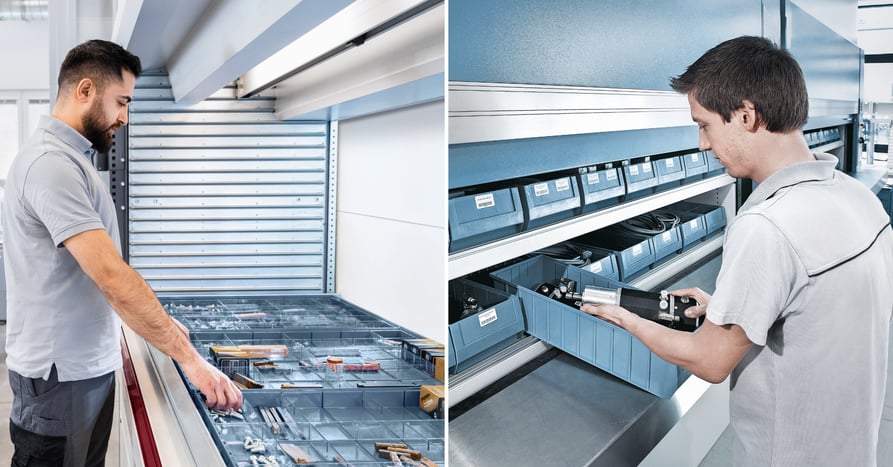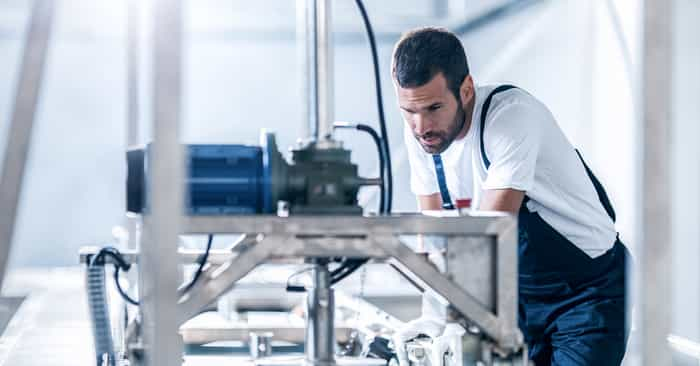What are the benefits of Vertical Carousel Modules & Vertical Lift Modules?
As two types of goods-to-person automated storage and retrieval machines, Vertical Carousel Modules and Vertical Lift Modules both offer:
- High-density storage of slow- to medium-velocity items. A 20 foot tall machine can provide anywhere from 5,000 to 7,000 locations (each roughly 6” x 6” x 4”).
- Automatic delivery of required items to a waist-high window for ergonomic, high-throughput picking in just a few steps.
- Full enclosures and lockable access for security.
- Maximized storage in a compact footprint by leveraging a facility’s overhead space.
How do they store items?
Vertical Carousel Modules are built with a series of carriers attached in fixed locations to a chain drive. Movement is powered by a motor, which sends the carriers in a vertical loop around a track in both forward and reverse directions—similar to a ferris wheel.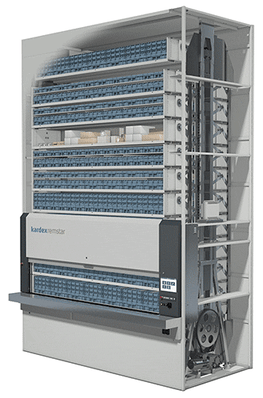
Vertical Lift Modules consist of two columns of trays with a mechanical inserter/extractor positioned in the center. The inserter/extractor travels up and down between the stored trays, automatically locating and retrieving them as needed – similar to an elevator with doors that open on both the front and rear.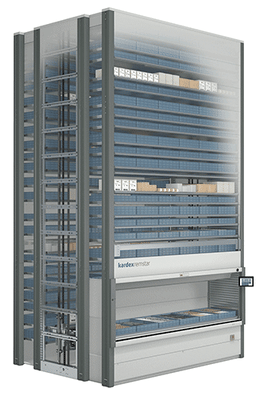
How do they measure up?
Footprints
Both technologies span roughly the same range of widths, not much of a differentiator there. When it comes to depths, Vertical Lift Modules can be about twice as deep as Vertical Carousel Modules – giving VCMs an overall narrower footprint. For specifics, let’s breakdown all the numbers for each technology.
A standard Vertical Lift Module unit is roughly 5- to 15-feet wide by 7- to 10-feet deep. The trays that store the inventory range from 4- to just over 13-feet wide by 2- to 3-feet deep, with a max product height of just over 28 inches. (Think ergonomics: You don’t want the trays to be too deep or the operator won’t be able to reach items with minimal effort.)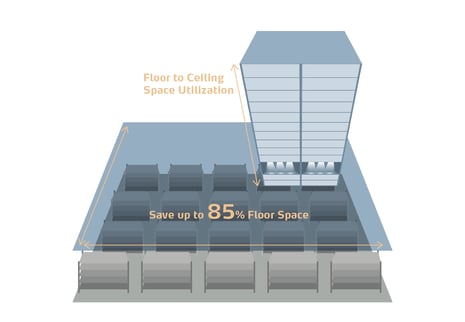
In comparison, Vertical Carousel Modules range from 6- to 13-feet wide by 4- to just over 5-feet deep. Designed for smaller product sizes, the carriers that store the inventory measure from 4- to almost 12-feet wide by 16- to 24-inches deep, with a product height up to 18.5 inches.
Heights
Vertical Lift Modules start at 8-feet tall and can be installed up to 98-feet high. In contrast, Vertical Carousel Modules start a little shorter, at just over 7-feet, and can reach up to 32-feet tall.
Although both machines can reach straight up to your ceiling, it doesn’t mean they always should. Often, the taller the machine, the slower the throughput. So it’s really up to you to determine the machine height that gives you the perfect mix of space savings and throughput. (Don’t worry; you’re not on your own. There are plenty of experts in the material handling field that can help you figure out the throughput rates of different-sized machines.)
Load Capacities
The latest Vertical Carousel Modules handle up to 1,430 pounds per carrier. Vertical Lift Modules can be outfitted with trays that handle up to 2,200 pounds each; for applications with heavier loads, lift-assist equipment can be added to a VLM. This is a major difference between the two machines: VCMs are more difficult to fit with ergonomic lifts and cranes – so if it’s heavy loads you're looking to store the VLM if probably the choice for you.
How fast are they?
As you’ve probably heard by now, like any automated system throughput rates in Vertical Carousel Modules and Vertical Lift Modules are application dependent. Depending on an individual machine’s configuration (mostly unit height), customer’s order profile (single line vs multi), single order or batch picking, etc. both units can perform at very similar throughput rates (VCMs can reach up to 400 items per hour while VLMs—depending on configuration—can deliver throughput up to 350 items per hour.)
Pick-to-Light
To reach those top throughput speeds, both types of machines need to be outfitted with light-directed picking technologies, such as pick-to-light. Located within the access window, these devices illuminate to show the operator where within the tray or carrier the required item is stored to eliminate search time.
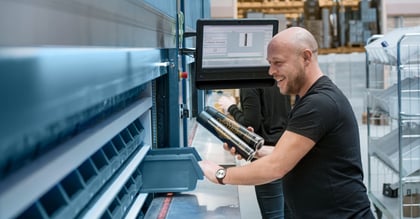 Vertical Carousel Module with TIC (transaction information center)
Vertical Carousel Module with TIC (transaction information center)
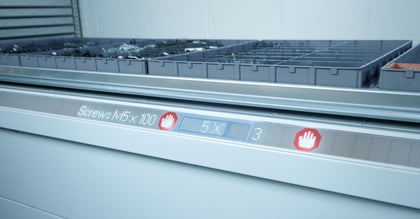
Vertical Lift Module with LED Pick to Light Technology
Slotting
Also, to achieve high throughput rates (regardless of how your Vertical Carousel Module or Vertical Lift Module is configured) slotting is critical. As you know, the slotting process typically doesn’t rank high on a warehouse manager’s list of favorite things to do. However, committing to regularly reviewing inventory data—such as seasonality, how often an item is picked and replenished, which items are commonly picked together, and so on—then figuring out the most appropriate place to store each item in the machine goes a long way toward achieving maximum throughput. So if it’s throughput your after you might as well embrace slotting from the start.
That’s because a properly slotted machine will keep the most frequently picked (and co-picked) items stored together on the same tray or carrier. The more picks an operator can make on a level before the unit moves the next level with picks (less travel time), the faster the picking. In a VLM, the items with the highest pick frequency are stored closest to the access window so the inserter/extractor doesn’t have far to travel to retrieve them. In a VCM, the carriers with the highest pick frequencies are adjacent (or at least a carrier or two away) so the drive chain only travels a short distance most of the time.
If it’s even more throughput that you’re looking for using VLMs and VCMs you’ve still got options. Learn more on batch picking and cross picking to increase throughput further.
Vertical Lift Module or Vertical Carousel Module – Which Is Right For You?
So now you've learned about the physical differences between Vertical Carousel Modules and Vertical Lift Modules. Now, it’s time to figure out which one is right for your operation and your stored items.
Product mix…
The size and weight of the items you plan to store in the machine—and how frequently your mix of products changes—are the key deciding factors when picking between a VLM and a VCM. That’s because each system stores items differently.
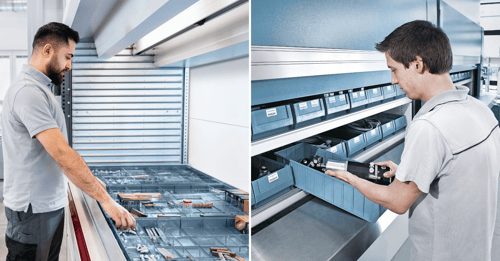
More sophisticated than Vertical Carousel Modules, Vertical Lift Modules use a height sensor that measures how tall the items placed in each storage tray are every time it’s put away. Integrated software crunches those numbers, then directs the VLM to store the trays dynamically—as close as one inch apart—to maximize storage density.
For example, if the tallest item you place on a tray measures 6.2inches tall, the Vertical Lift Modules will store it in a 7-inch space inside the machine. If that product is picked and the next tallest product remaining in the tray measures 3.5 inches tall, the VLM will automatically place the tray in a 4-inch-tall location. The machine prioritizes compressed storage to give you the highest storage density possible.
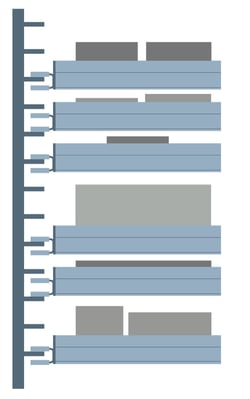
Vertical Lift Module tray spacing allows dynamic storage.
Conversely, in Vertical Carousel Modules, the carriers are spaced evenly in fixed positions. The shelf levels within the carrier can be adjusted up or down to compress the vertical space – but not automatically, adjustment is a manual task. Because nobody wants to pay to inventory air, it’s critical to know the heights of your stored items when specifying the machine so as to get those shelves as close together as possible. That makes the VCM an ideal choice to store products that are similar in height (usually under 8”), and whose sizes do not often change.
That said, every carrier in a Vertical Carousel Module can be subdivided further (both vertically and horizontally) to maximize storage density within the unit. In fact, they are frequently divided into two or three shelves to separate items for slotting and organization. Adjusting those dividers—while possible to do—is a tedious task that requires all the product to be removed first, then the dividers unbolted, moved and re-attached in a new position.
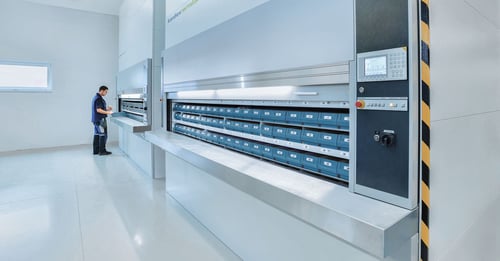 Vertical Carousel Module fixed location spacing
Vertical Carousel Module fixed location spacing
While it’s not a big deal to change one carrier, if inventory changes frequently enough that a new carrier configuration is required often, a lot of labor hours will be spent to maximize the machine’s storage density. That’s why Vertical Carousel Modules are a great choice if your product mix is pretty consistent in size.
So, which one do you need?
Because of their construction, operation and product handling differences, VCMs and VLMs are ideal for different applications. When you’re deciding which system is right for you, keep the following in mind…
Vertical Carousel Modules work best in situations with:
- Ceiling heights under 25 feet
- Stored parts sharing relatively similar dimensions
- Items that can be hand-picked without lift assistance
Vertical Lift Modules work best in situations with:
- Ceiling heights up to 100 feet
- Highly variable sizes and weights of stored parts
- Frequently changing inventory mix
- Heavy items that require lifting assistance for the operator to safely handle
In conclusion...
While determining the material handling technology you need isn’t exactly rocket science, it is some kind of science. Would you re-side your house without asking the advice of a specialist – I wouldn’t. So don’t hesitate to ask questions and engage a material handling expert in your quest – we have people who have been doing this work for over 30 years (wow that’s commitment!). They know a thing or two about what you’re looking to accomplish, and they’re here to help.
Need more insight into whether a Vertical Lift Module or Vertical Carousel Module is right for your operation?

